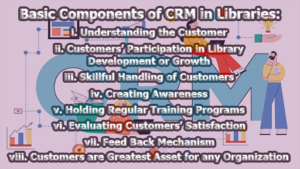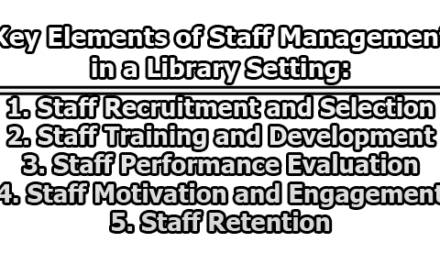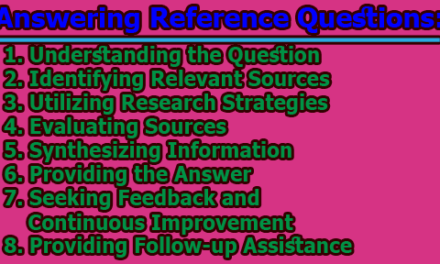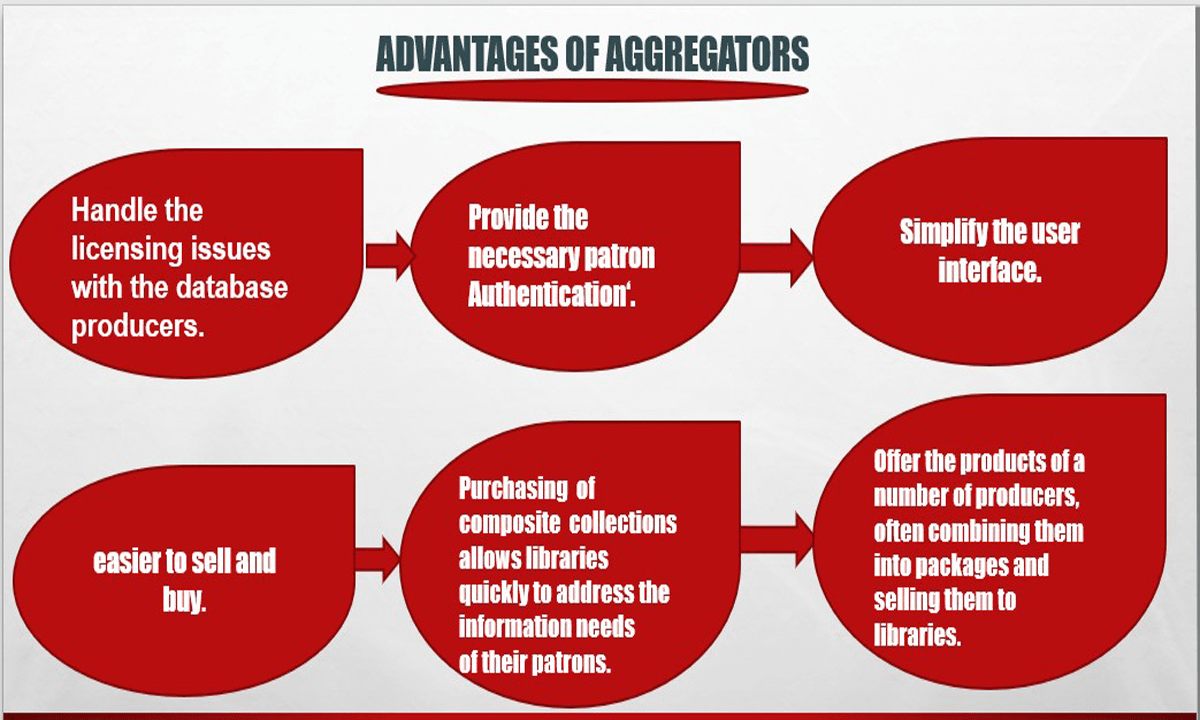Basic Components of CRM in Libraries:
CRM (Customer Relationship Management) is inevitable in a competitive world. The customer is a king in the service sector and any failure to understand his/her demand would shake the sustainability in the market. To develop the best relationship with customers is to understand their requirements and demands. Failure to do this is an adverse impact on resource utilization. So, need to be adopted the concept of CRM and succeeds implementing is never declined any demand proposed by sanctioning authority or concerned institution/organization/management based on basic components of CRM in libraries.
Basic Components of CRM in Libraries:
Some of the important basic components of CRM in Libraries are briefly discussed below:
i. Understanding the Customer: Understanding the customer is the most important aspect in the process of implementing Customer Relationship Management (CRM). Better understanding the customer helps in building a comfortable relationship with him/her. A customer may get satisfaction over the service rendered to him/her and by understanding them well and through maximizing the utilization of existing information resources. Following are the examples of better understanding the Library customers:
- Creating personals profiles.
- Interactively with intensively.
- By assisting customers in searching the information materials.
ii. Customers’ Participation in Library Development or Growth: Customers are the salient components of the libraries that are responsible for adding new resource material and hi-tech infrastructure. Customers come to the library time and again and increase the utilization of information resources and services leading to changes taking place as per their utilization and demands. It is possible only by offering pleasantly the expectation of services – a feature that maintains the amicable relationship. Frequent visits to the library and information center become an instrument for shaping the center accordingly and make to the entire intellectual fulfillment. Following are some of the examples:
- Smart card implementation
- Barcode
- On line Public Access Catalogue
- Library Software
iii. Skillful Handling of Customers: Handling customer is an art. It depends on the librarian whom the user approaches and the customer who meets the librarian. Effective articulation skill is necessary to handle customers in a healthy and satisfactory way. The library term should develop the art of listening and understanding customer requirements. To satisfy all kinds of customer requirements the library team needs to inculcate better listening skills to handle the abnormal customers in an efficient way. Following are some of the examples:
- Pleasing behavior
- Answering cool and calmly to initiating and repeated question
- Assisting the customers in utilizing the resources and facilities
iv. Creating Awareness: A customer should be made aware of each and every development taking place in the library and information center. This should be done by sending updated information to all customers via email and requesting them to send their feedback issue. The majority of libraries commonly send the list of new arrivals to the customers. In the changing situations, customers expect quick and comprehensive information from the library and information centers. The library staff should conduct innovative programs in order to cater to the different needs of customers to their satisfaction. Following are some of the examples:
- Alert setting
- Conference/symposium/seminars information updating
- Sending latest development information (government initiatives/public funding)
v. Holding Regular Training Programs: Libraries should provide training to customers regularly. This kind of training program attracts more and more customers and the latter they feel happy with the library services. Holding training programs regularly creates a customer-centric environment which induces freedom of utilizing existing library resources instead of referring the library team for each and everything. Following are some example;
- Library orientation program
- Using library facilities training (database search/OPAC)
- Subjects expert talk
vi. Evaluating Customers’ Satisfaction: We can analyze this through statistics, which does not require any CRM software or tools. Libraries use different automation software to carry out several library activities. Using this package generates the data in detail of the individual user which may be assessed before the implementation of CRM and after its successful implementation. If a customer is not satisfied with the service rendered by the concerned library and information center he/she reduce the visit and does not avail of the existing information resources for other reasons. In addition to getting the date of individual customer visits will bring out the date of newly issued membership rate, the number of transactions, per day transactions, facts moving titles, highest issues and document, etc. The data helps the librarian to conclude whether the existing services and resources are very beneficial to customers and the library personnel is performances is well in delivering service to the customer, example;
- Utilizing statistical data of library membership, additions, and transactions.
vii. Feed Back Mechanism: Vital information to any system keep continuous improvisation. Unless not having customer’s feedback, it is difficult to analyze our services and attitudes. Two kinds of feedbacks we can able to see one is positive and another is negative. Positive feedbacks are always open-minded and offering processes to improve and negative feedbacks not offer solutions and expect criticism or comments. Libraries can practice this system according to their comfort with customers and visitors. Feedback can obtain by filling some forms and questionnaire adopted by libraries to achieve customer satisfaction.
viii. Customers are Greatest Asset for any Organization: The fact that customers are the greatest asset in Library Science defines the value of library and information center by providing publicity of the resources and services and the manner in which the team handles the customer. These traits increase the institutional values and earn more respect, they create a special place in the organization. Library’s collection development is directly linked to its customers.
It is apparent that customers are the key drivers of the changes. They are responsible for new products and services introduced into the market. They need to understand them very well to keep them happy and make them visit again by offering the expecting service. Libraries are not away from the changes taking place in the market which tries to retain by satisfying the customers by supplying the information on products and service providing companies. Libraries need to develop strong relationships with their existing customer base by creating expected service in a pleasant manner. Since the loyalty of the customers is prone to change in the market-driven and fasting changing scenario.
Reference:
Kumar, P.V., Raghavendra, R. (2008) CRM Practices in Libraries. ETTLIS, 498-503.

Assistant Teacher at Zinzira Pir Mohammad Pilot School and College










